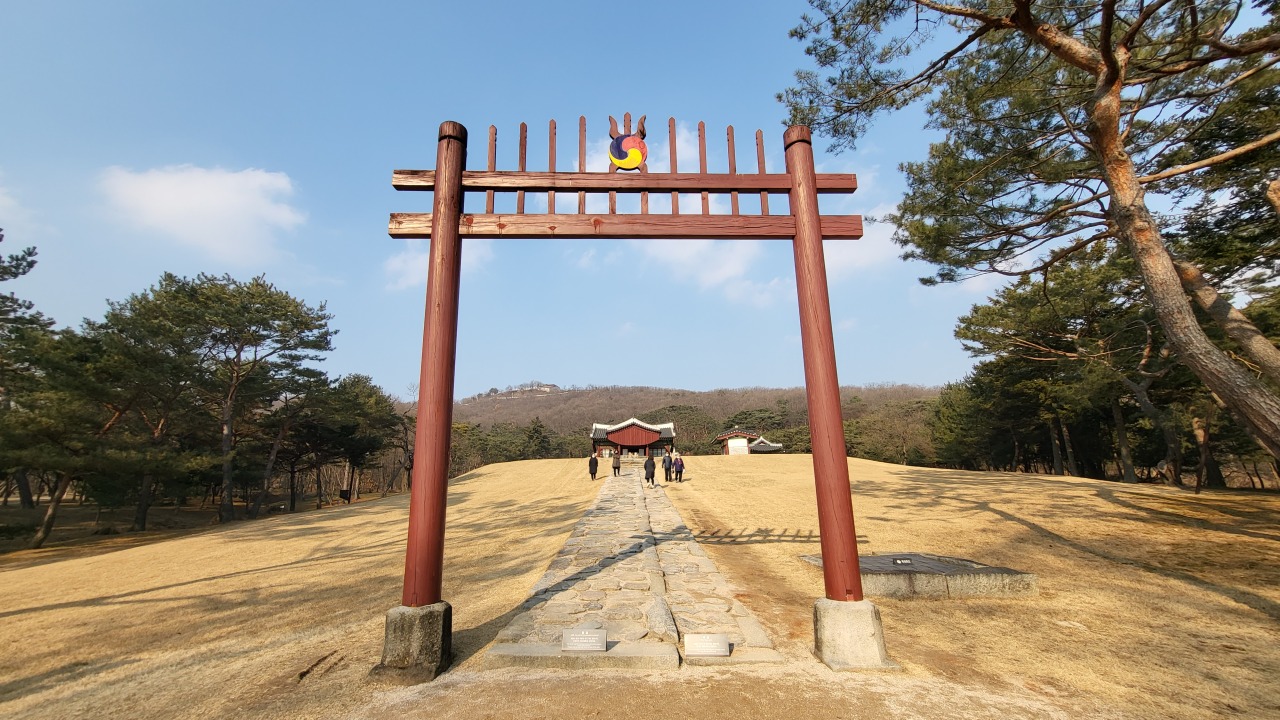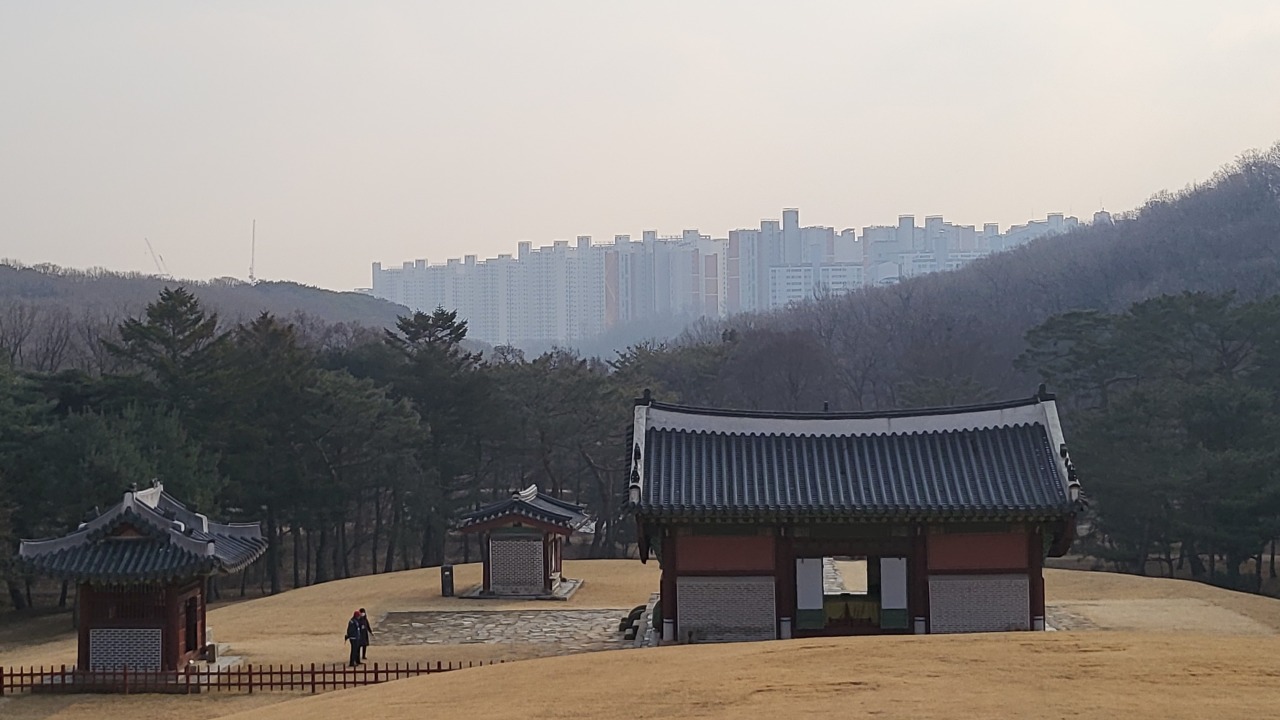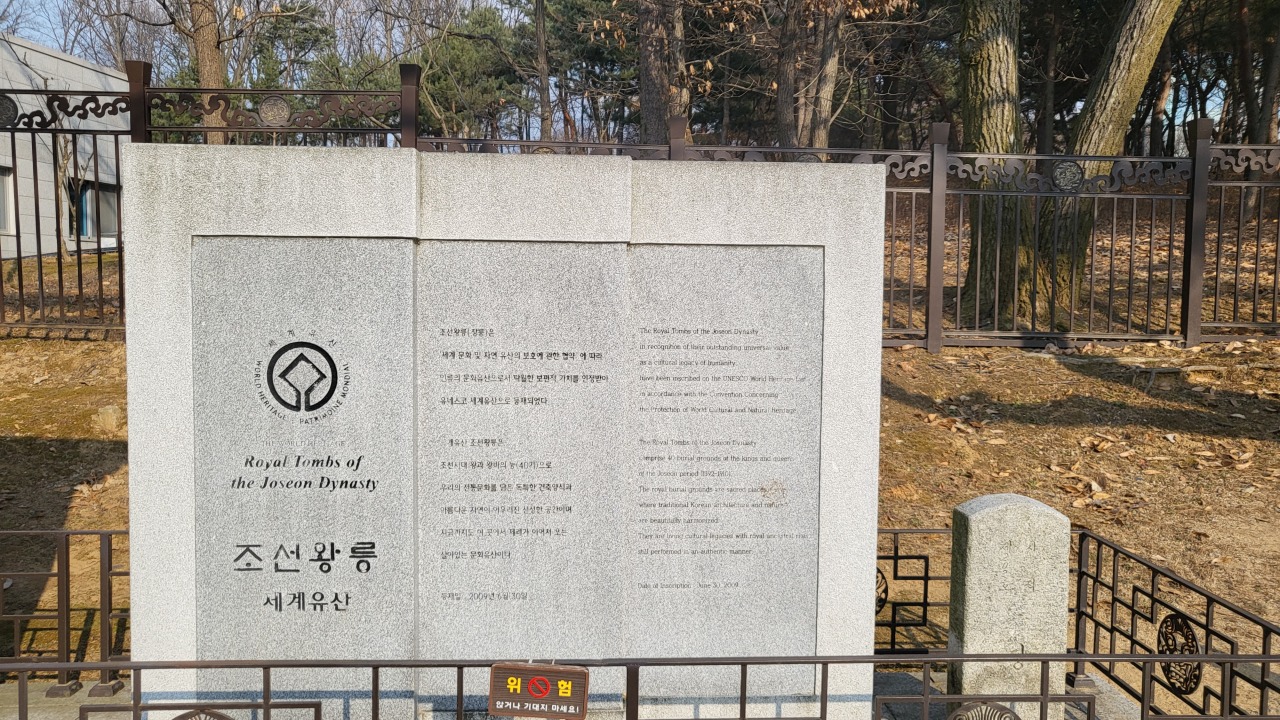 |
The royal tombs of the parents of King Injo, the 16th ruler of Joseon, were designated a UNESCO World Heritage Site in 2009. (Kim Hae-yeon/ The Korea Herald) |
GIMPO -- Twelve years after the Joseon royal tombs Jangneung in Gimpo, Gyeonggi Province, were made UNESCO World Heritage Sites in 2009, it is faced with the possibility of having the designation removed, according to the Cultural Heritage Administration.
In August, the CHA ordered its committee of experts to review 19 of the 44 apartment buildings undergoing construction by three developers for breach of the cultural property protection law as they were located within 500 meters of the royal tombs. Occupants of the new apartments are expected to move in between June to September this year. The CHA requested a suspension of construction during the review period.
A number of options were brought to the table, including tearing down the upper floors or planting trees to block the apartments from view, but on Dec. 23, all three construction companies said they would not take any action to safeguard the vista.
In the case brought by the firms against CHA’s construction suspension order, the court ruled that the developers could proceed with the building of seven apartment buildings that are relatively far away from the tombs.
On appeal, the higher court ruled in favor of the three companies, allowing the construction of all of the high-rise buildings in dispute. The CHA has lodged an appeal and now the case is to be decided at the Supreme Court.
The controversy highlights the fundamental question concerning development and conservation, pitting the need for housing against the protection of valuable heritage.
 |
The main gate to the UNESCO-listed royal tombs, Jangneung, in Gimpo, Gyeonggi Province (Kim Hae-yeon/ The Korea Herald) |
‘We should think from scratch’
On the afternoon of Dec. 29 at the royal tombs, a free admissions day that comes every fourth Wednesday of each month, children on family outings could be heard laughing from the parking lot while many elderly couples were seen strolling around.
Entering the gate facing the two royal tombs placed side by side, which belong to the parents of Joseon’s 16th ruler, King Injo, one might wonder what the controversy is about -- no buildings are seen behind the tombs. Turning around to face the other way, the tops of some apartment buildings are just visible, but not to a great extent.
To get a better view at a vantage point, one needs to climb up the gentle slope of the tomb. The Korea Herald requested the site operation manager for access to the tombs.
From higher up, the high rises appear bigger until, at a certain point in the climb, the vista is dominated by the apartment buildings.
 |
A view of Gyeyangsan is partially blocked by new apartments in Gimpo, Gyeonggi Province, as seen from the royal tombs, Jangneung, on Dec. 29. (Kim Hae-yeon/ The Korea Herald) |
To better understand the controversy, one needs some knowledge of the philosophy behind the Joseon royal tombs.
The website of the CHA’s Royal Tombs’ Division introduces the main characteristic of the royal tombs of the Joseon era: “The hierarchy of the space is strictly divided and leads to a closed image for worshiper(s), but should act as an open image for the owner(s) of the tomb.”
“I think we (Koreans) are in a transition period where we are putting more emphasis on the importance of preserving cultural heritage sites, which we were unaware of during the rapid development and urbanization of the last 50 years or so,” a staffer on duty told The Korea Herald. “If you tie your shoelace the wrong way, there is no other option than tying it up again from the start. And that’s the case with Jangneung. The case will serve as a reference for other similar issues in the future.” The staffer, who requested anonymity, added that it has become a sensitive matter to bring up in the neighborhood since it concerns huge financial costs.
“I think the CHA made a mistake in not attending to the situation for such a long time after the revision of the relevant protection law,” a woman in her mid-50s, who has lived in Gimpo for more than 20 years, said. “At this point when I put myself in the prospective residents’ place, planting trees would be the most realistic solution. But I am skeptical of finding trees tall enough to block the apartments from view.”
’Public notice given upon law revision’
Although recognizing the financial burden of the property developers and the anxiety of prospective residents, the CHA says it has no other choice but to prioritize historical value and original intentions of the heritage.
While the construction companies are arguing that the Permission for Alteration of Current State and Scenery Plans was issued by the local government, the CHA insists that it had distributed public announcements when changes were made to the cultural heritage protection law and that both the firms and the local governments should have been aware of the revisions.
 |
A signpost at the entrance introduces UNESCO-listed royal tombs from the Joseon Kingdom. (Kim Hae-yeon/The Korea Herald) |
The UNESCO’s recent emphasis on heritage preservation in the Execution of Convention Concerning the Protection of the World Cultural and Natural Heritage, is another reason for concern for the CHA. Today, the UNESCO stresses much importance on the preservation management after the initial enlisting of the heritage, such as restricting redevelopments and establishing buffer zones. If the Outstanding Universal Value is found dismantled, the heritage will permanently be removed from the list, according to the UNESCO.
’Preparation for future is crucial’The dates and period concerning the revision of the law, the public announcement and permission of land usage have also been a matter of debate.
“Since locations near Gimpo’s Jangneung had not been updated on the Written Confirmation of Land Use Planning until November, there is little possibility that construction firms could have kept track of the revised law, although that would have been desirable,” Lee Myeong-hun, dean of Hanyang University’s Graduate School of Urban Engineering and president of the Korea Urban and Real Estate Association, told The Korea Herald during a phone interview Thursday.
Lee said that it is of utmost importance, from now on, to thoroughly investigate “special-purpose areas” that are designated for the protection of cultural and historic properties. It is crucial for the public to easily recognize the exact guidelines on land usage, according to Lee.
“There are conflicting analyses, but from my research, I would say cutting down the height of the buildings that have already been built will entail many risks,” Lee added.
However, a Seoul-based attorney, who wished to remain anonymous, suggested that whether the public announcement of the revised law had effectively been delivered to local governments or not is not the matter of discussion, saying that a revised law goes into effect the moment it is legislated.
By Kim Hae-yeon (
hykim@heraldcorp.com)











